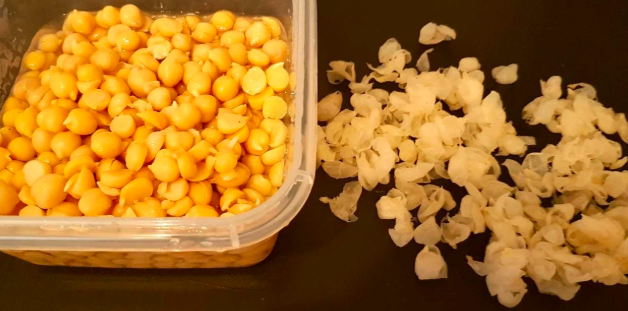I’d have an issue with a paste made out of roasted soybeans or pinto beans. Legumes are really hard to digest – there are countless irritant compounds in the skins of the legume. Our human gut does not break this stuff down well which is why cuisine around the world develped things like refried beans…overnight soak the beans – rinse and change the water. Then boil the beans, changing the water twice. Then mashing and recooking the beans. Why would humans go through all the trouble? Because without proper handling, the legumes caused malnutrition and GI distress. Another strategy is to peel the skins off – like can be done with garbanzo’s but the skin is too integrated with other beans. So if you eat beans…eat them in a traditional form – well soaked and cooked or peeled garbanzo beans as the image shows below.

So what is it about Peanut Butter. There is no other legume that is eaten in a non-soaked form. Traditionally, peanuts were soaked and boiled – the making of peanut butter is only about a hundred years old and it really is a bad idea.
Let me copy a couple paragraphs from the Blood Code book…
A word about soybeans and peanuts, and why they should be avoided in their processed forms: These two legumes have been among the most processed and misused foods in the convenience-food culture. Soy products are apparently on shaky ground, as they have been associated with thyroid and other hormonal conditions.[i] Yet, on the other side, I’ve read other industry research that refers to soy products as some kind of miraculous medical food.
Soy protein isolate and textured vegetable protein are foods that did not exist in the human diet until a generation ago. The resultant processed foodstuff challenges your human digestive system. Over the past few thousand years that beans have been part of the human diet, soybeans were boiled, not extracted out to be soy flour and soy protein. I suspect the growing incidence of soy protein allergy is a result of our inability to digest the food in its processed form.
Peanuts
went through a similar process. Peanuts were always boiled in various native cuisines.
Boiled for an hour in salt water, fresh in their pods, the peanuts were eaten like
the popular Japanese dish, edamame. Only in the 1930s did the Skippy Corporation
patent and begin the process of roasting the peanuts rather than boiling them, to
make peanut butter. This caused an emulsification of the fats that allowed the product
to be more spreadable. Just add sugar from jelly and you have the modern way peanuts
are eaten. While spreadability meets the needs of convenience, nutrition and digestibility
are radically compromised, challenging the human digestive and immune systems. Like
soybeans and other legumes, skipping the process of boiling the peanut leaves the
indigestible outer skin on the legume intact, causing stomach and digestive problems,
poor nutrition, and potential allergies.
[i] Doerge, D. R., Sheehan, D. M. Goitrogenic and estrogenic activity of soy isoflavones. Environ Health Perspect. 2002 Jun; 110 Suppl 3:349–53.



Comments are closed.